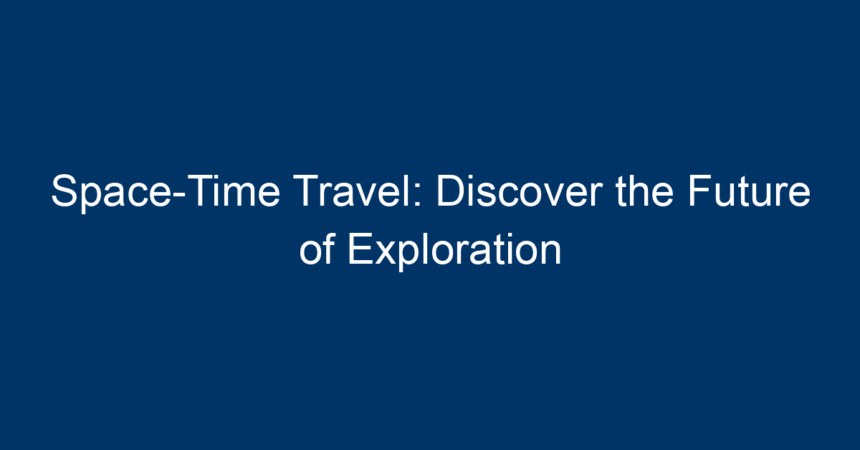Introduction
Imagine stepping into a portal that whisks you away to a time long before you were born—or even catapulting you to a future where humanity has colonized distant planets. The fantastical concept of space-time travel has long captured our imaginations in science fiction movies and novels. However, recent advances in physics and technology are bringing us closer to turning this dream into reality. In this article, we will explore the intriguing aspects of space-time travel, its theoretical foundations, and what it means for the future of exploration.
Understanding Space-Time
Before diving into the concept of space-time travel, let’s briefly cover what space-time is. Space-time merges the three dimensions of space with the fourth dimension of time, creating a singular fabric that forms the universe. According to Einstein’s theory of relativity, space and time are interconnected, meaning that the presence of mass can warp this fabric, leading to phenomena such as gravity.
The Fabric of Our Universe
-
Space: This refers to the three-dimensional extent in which objects and events occur. Traditional movements can be thought of purely in spatial terms—moving left or right, up or down, and forward or backward.
- Time: This fourth dimension is often perceived as a linear progression from past to present to future. However, it’s intricately tied to space, leading to the concept of time dilation, where time can move differently depending on relative speeds and gravitational fields.
Theoretical Frameworks for Space-Time Travel
Beyond the imaginative realms of fiction, certain scientific theories offer foundations for the possibility of space-time travel.
1. Wormholes: Portals Through Space-Time
Wormholes are theoretical passages through space-time that could create shortcuts for long journeys across the universe. Proposed by Einstein and Nathan Rosen, these ‘bridges’ could potentially connect disparate points in space and time.
-
How They Work: Imagine a folded piece of paper representing the universe; creating a wormhole is like punching a hole through the paper, allowing for instantaneous travel between two distant points.
- Challenges: While fascinating, creating or finding a stable wormhole poses immense scientific challenges. Theoretical constructs often require exotic matter with negative energy density to keep a wormhole open.
2. Time Dilation: The Relative Nature of Time
As described in Einstein’s special theory of relativity, time dilation presents a way to ‘travel’ into the future inadvertently.
-
The Twin Paradox: This thought experiment shows how one twin traveling at near-light-speed would age slower than their twin remaining on Earth. Upon returning, the traveling twin would effectively leap into the future.
- Real-World Applications: Scientists have confirmed time dilation through precise clocks on satellites and jets, proving that time is indeed relative.
3. Cosmic Strings: Rigid Fibrils of Space-Time
These theoretical one-dimensional defects in the fabric of space-time could allow for manipulation of the universe in profound ways.
-
Manipulating Time: If cosmic strings exist, they could warp space-time around them, potentially enabling travel across vast distances or even through time.
- Scientific Inquiry: While still conjectural, exploring cosmic strings opens new avenues in understanding how to navigate the universe.
Current Research and Technological Advances
While theories abound, researchers today are diligently exploring practical applications that could eventually facilitate space-time travel.
Quantum Mechanics: The Future Frontier
Quantum mechanics tells us that many particles exist in superposition; they occupy multiple states simultaneously until observed. This principle gives rise to theories like quantum entanglement, which could inform future technologies in space-time exploration.
Artificial Intelligence in Physics Research
Advancements in AI enhance our understanding of complex concepts in physics. By simulating various conditions, AI can help predict phenomena that may contribute to our understanding of space-time travel, drastically reducing research time.
Experimental Physics
Ongoing experiments using particle accelerators investigate the potential interactions of particles at high speeds. These studies could unveil secrets of space-time manipulation and perhaps open doors to new travel methods we couldn’t previously fathom.
Space-Time Travel in Popular Culture
The concept of space-time travel has inspired countless stories, movies, and television shows, embedding itself into popular culture.
Literature and Cinema
-
Books: Works like "The Time Machine" by H.G. Wells have set foundational ideas in motion, exploring the consequences of time travel on society.
- Movies: Films like "Interstellar" and "Back to the Future" portray compelling narratives involving space-time, offering audiences a captivating glimpse of the possibilities.
Video Games and Virtual Reality
Games that incorporate time travel mechanics, such as "Portal" or "Chrono Trigger," invite players to engage with concepts of time and space in interactive ways, fostering curiosity about the scientific possibilities.
The Ethical Implications of Space-Time Travel
As we inch closer to making space-time travel a reality, ethical considerations must precede these advancements. The ability to change events in the past could have irreversible consequences.
Historical Repercussions
Imagine altering a crucial moment in history. Could it lead to a better future, or would unforeseen consequences spiral out of control? The power of choice in manipulation could burden humanity with the responsibility of reckoning with its past.
Societal Impact
Should space-time travel become accessible, it could create societal disparities between those who can afford such technologies and those who cannot. Questions of regulation, governance, and equitable access will emerge, demanding critical dialogue among scientists, ethicists, and policymakers.
Conclusion: The Road Ahead
As we stand on the brink of a potential revolution in exploration, the idea of space-time travel invites us to dream boldly while grounding those dreams in scientific inquiry. The foundations of this journey lie in theoretical physics, advanced technologies, and responsible discussions around ethical implications.
For those eager to explore, consider engaging in STEM education, supporting scientific literacy programs, or simply staying informed about breakthroughs in physics. The future of space-time travel may beckon not so far away, inviting you to be a part of the next monumental chapter in humanity’s story.
Embrace the possibilities and get ready for an exciting adventure into the unknown!




